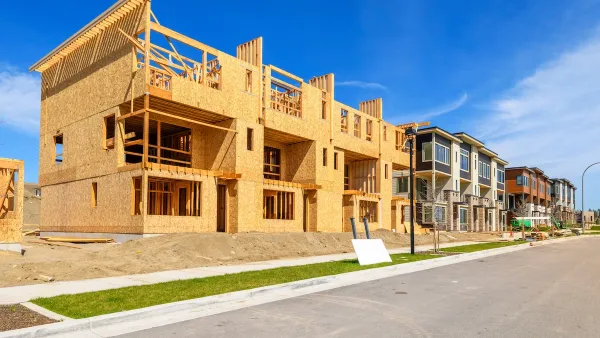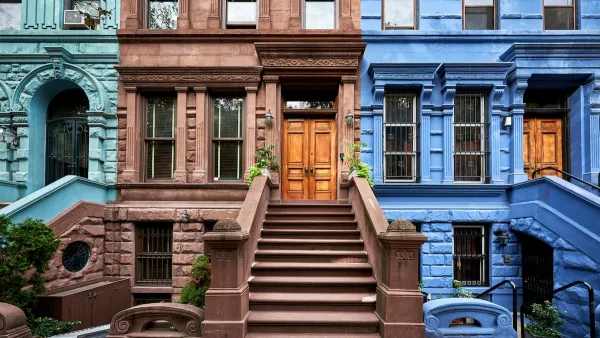This post offers a critique of claims that there is an ideal, "Goldilocks density."

In recent years, I have read numerous references to the phrase "Goldilocks density": the idea that there is one level of density that is neither too high nor too low, but just right. For example, Lloyd Alter wrote some years ago that this perfect density is "dense enough to support vibrant main streets with retail and services for local needs, but not too high that people can't take the stairs in a pinch."
But it seems to me that the idea of a "perfect density" is inherently a bit dictatorial. Different people prefer different levels of density and different building heights: even in a pre-sprawl world, some people lived in high-rises, some in very dense rowhouse neighborhoods, others in more bucolic streetcar suburbs. Perhaps the market should be allowed to accommodate these varying preferences.
In fact, cities with a wide range of densities tend to be more walkable and transit-friendly: cities like New York and Boston have dense cores, less dense residential neighborhoods, and sprawling suburbs, while in car-oriented cities, the gap between the least dense and most dense areas is far smaller. For example, Manhattan (about 70,000 people per square mile) is about 15 times as dense as suburban Nassau County, while Virginia-Highlands (one of Atlanta’s more walkable areas) has only a little over 6,000 per square mile—only three times as dense as suburban Cobb County.
Furthermore, what makes a density "perfect"? If a goal of zoning policy is to limit automobile-related pollution, it seems that there is no American density that is "too high." Car use and ownership is lower in New York City than in medium-density cities, and lower in high-density Manhattan than in the rest of New York City. 78 percent of Manhattan households own no car, as opposed to 55 percent in the city as a whole, 25-30 percent in medium-density Chicago and San Francisco, and much lower percentages in car-dependent Sunbelt cities. As I wrote several years ago, modeling by John Holtzclaw suggests that there is no upper limit to the relationship between density and vehicle miles traveled: a neighborhood with 500 units per acre will have less vehicle travel than one with 100 units per acre.
Moreover, different density levels make sense for cities of different sizes. Los Angeles has over 7,000 people per square mile and is quite spread out and automobile-oriented. Why? Partially because in a city of over 3 million people, that level of density still demands a lot of territory. So it seems to me that Los Angeles must become a lot more dense in order to become one of this nation's more transit-friendly cities. By contrast, a 20,000-person small town with that level of density would encompass less than 3 square miles, which means that everyone would live within a mile or so of the city core. In other words, a huge city needs to be pretty dense to be transit-friendly, while a small city can achieve the same results with much lower levels of density.
Similarly, a city suffering from a housing shortage needs lots of new housing, which means it must either become more dense or sprawl further into the countryside. By contrast, a cheap, declining city might not need more housing in order to be inexpensive.
Alter (who I think may have been the first to coin the term) seems to have been primarily interested in fighting proposals for taller buildings. But height and density are not synonymous: as Alter himself has noted, low-rise neighborhoods can still be quite dense. So if height is not necessary for density, it logically follows that even opponents of tall buildings should be willing to tolerate neighborhoods like New York's West Village, which (at 70,000 people per square mile) are more compact than almost any American neighborhood outside Manhattan. In fact, even higher densities are consistent with mid-rise living: Hong Kong's Mongkok has 340,000 people per square mile, but a look at Google Street View suggests that most buildings there are 5-20 stories: often tall enough for elevators, but by no means skyscrapers. Thus, it seems to me that skyscraper-phobia does not require that cities be limited to current densities, or even to any density lower than that of Mongkok.

Maui's Vacation Rental Debate Turns Ugly
Verbal attacks, misinformation campaigns and fistfights plague a high-stakes debate to convert thousands of vacation rentals into long-term housing.

Planetizen Federal Action Tracker
A weekly monitor of how Trump’s orders and actions are impacting planners and planning in America.

In Urban Planning, AI Prompting Could be the New Design Thinking
Creativity has long been key to great urban design. What if we see AI as our new creative partner?

King County Supportive Housing Program Offers Hope for Unhoused Residents
The county is taking a ‘Housing First’ approach that prioritizes getting people into housing, then offering wraparound supportive services.

Researchers Use AI to Get Clearer Picture of US Housing
Analysts are using artificial intelligence to supercharge their research by allowing them to comb through data faster. Though these AI tools can be error prone, they save time and housing researchers are optimistic about the future.

Making Shared Micromobility More Inclusive
Cities and shared mobility system operators can do more to include people with disabilities in planning and operations, per a new report.
Urban Design for Planners 1: Software Tools
This six-course series explores essential urban design concepts using open source software and equips planners with the tools they need to participate fully in the urban design process.
Planning for Universal Design
Learn the tools for implementing Universal Design in planning regulations.
planning NEXT
Appalachian Highlands Housing Partners
Mpact (founded as Rail~Volution)
City of Camden Redevelopment Agency
City of Astoria
City of Portland
City of Laramie






























